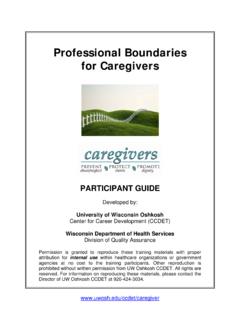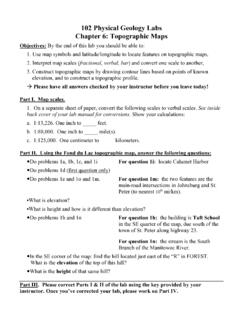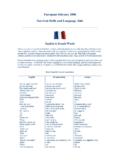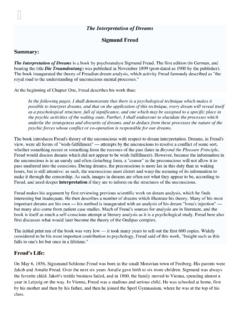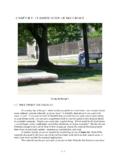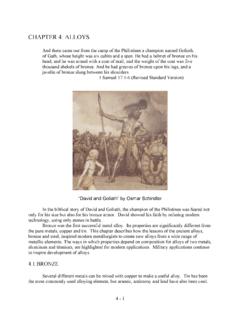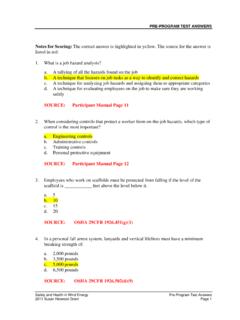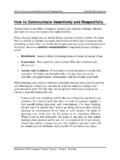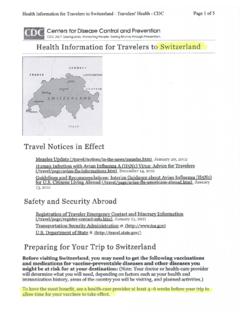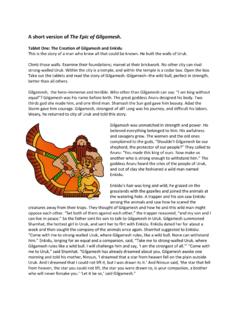Transcription of Epic of Gilgamesh - University of Wisconsin–Oshkosh
1 Epic of Gilgamesh Gilgamesh was an historical king of Uruk in Babylonia, on the River Euphrates in modern Iraq; he lived about 2700 Although historians (and your textbook) tend to emphasize Hammurabi and his code of law, the civilizations of the Tigris-Euphrates area, among the first civilizations, focus rather on Gilgamesh and the legends accruing around him to explain, as it were, themselves. Many stories and myths were written about Gilgamesh , some of which were written down about 2000 in the Sumerian language on clay tablets which still survive; the Sumerian language, as far as we know, bears no relation to any other human language we know about. These Sumerian Gilgamesh stories were integrated into a longer poem, versions of which survive not only in Akkadian (the Semitic language, related to Hebrew, spoken by the Babylonians) but also on tablets written in Hurrian and Hittite (an Indo-European language, a family of languages which includes Greek and English, spoken in Asia Minor).
2 All the above languages were written in the script known as cuneiform, which means "wedge-shaped." The fullest surviving version, from which the summary here is taken, is derived from twelve stone tablets, in the Akkadian language, found in the ruins of the library of Ashurbanipal, king of Assyria 669-633 , at Nineveh. The library was destroyed by the Persians in 612 , and all the tablets are damaged. The tablets actually name an author, which is extremely rare in the ancient world, for this particular version of the story: Shin-eqi-unninni. You are being introduced here to the oldest known human author we can name by name! This summary is derived from several sources: translations, commentaries, and academic scholarship on the Shin-eqi-unninni tablets. Verses are derived from several English and French translations in consultation with the English and German language commentaries and with the Babylonian text. For the entire text, you should turn to The Epic of Gilgamesh , trans.
3 By Maureen Gallery Kovacs (Stanford: Stanford University Press, 1990), or Gilgamesh , translated by John Maier and John Gardner (New York: Vintage, 1981) As you read this short summary, ask yourself the following questions: 1. Themes. The first things you want to sort out are the ideas which seem to animate the work. One of the problems with literature, art, mythology, etc., is that you can never be quite sure that you've correctly identified the central ideas or philosophy of the work, but you should take a stab at it anyway. Keep in mind that there is no such thing as one and only one idea in a work of literature, and that in most art and literature, like life, there is no one correct answer concerning any single issue. To identify an idea, question, or theme that the work seems to treat, look for specific places where that idea seems to be a concern; mark these passages and combine and contrast them when you begin to try to resolve what the work seems to be about.
4 The questions I provide in these reading notes are meant to organize the families of questions you can bring to these texts. 2. Structure. Try to define for yourself the overall structure of the story. This narrative has two distinct parts; what are these parts and how are they separated? How do events in the second part of the narrative repeat or develop ideas in the first part of the narrative? Do these events contrast with or develop themes and values articulated in the first part of the narrative? 3. The Nature of the Heroic. When you read the myth, notice how Gilgamesh is presented as superhuman, so powerful that the gods create a counterpart to moderate his desires and actions. Do you get the sense that Gilgamesh and Enkidu should have spared the demon of the cedar forest? Despite all of Gilgamesh 's power, he is unable to prevent Enkidu's death, and the narrative changes direction. How can one describe Gilgamesh as a hero in the last half of the work?
5 What has he achieved at the end of the poem? Why is this important? 4. The Gods. The gods in Gilgamesh are a bit problematic. How do the gods behave? What is their relation to humans? How much freedom do humans have, or are they merely subject to the will of these gods? 6. The Flood. The story of the Flood is a familiar one, as we shall see in Genesis and Popol Vuh (Plato also gives an account of the Flood and the city of Atlantis in the dialogue, Critias ; the Nez Perce of the Palouse also have a flood story in which the only humans that survived did so by climbing the mountain, Yamustus, that is, Steptoe Butte). The earliest surviving reference to the Flood goes back to 1900 Why is it brought in here? Why do the gods bring on the Flood? Is any reason given? (Later compare the reasons for the floods in Genesis and Popol Vuh.) What does it tell us about the nature of history and the relation of the gods to humanity?
6 Tablet 1 The one who saw all [Sha nagba imuru ]I will declare to the world, The one who knew all I will tell about [line missing] He saw the great Mystery, he knew the Hidden: He recovered the knowledge of all the times before the Flood. He journeyed beyond the distant, he journeyed beyond exhaustion, And then carved his story on stone. [naru : stone tablets ] This great hero who had all knowledge [nemequ ], Gilgamesh , built the great city of Uruk; the tablet invites us to look around and view the greatness of this city, its high walls, its masonwork, and here at the base of its gates, as the foundation of the city walls, a stone of lapis lazuli on which is carved Gilgamesh 's account of his exploits, the story you are about to hear. The account begins: Gilgamesh , two-thirds god and one-third human, is the greatest king on earth and the strongest super-human that ever existed; however, he is young and oppresses his people harshly.
7 The people call out to the sky-god Anu, the chief god of the city, to help them. In response, Anu creates a wild man, Enkidu, out in the harsh and wild forests surrounding Gilgamesh 's lands. This brute, Enkidu, has the strength of dozens of wild animals; he is to serve as the subhuman rival to the superhuman Gilgamesh . A trapper's son, while checking on traps in the forest, discovers Enkidu running naked with the wild animals; he rushes to his father with the news. The father advises him to go into the city and take one of the temple harlots, Shamhat, with him to the forest; 1 when she sees Enkidu, she is to offer herself sexually to the wild man. If he submits to her, the trapper says, he will lose his strength and his wildness. Shamhat meets Enkidu at the watering-hole where all the wild animals gather; she offers herself to him and he submits, instantly losing his strength and wildness, but he gains understanding and knowledge.
8 He laments for his lost state, but the harlot offers to take him into the city where all the joys of civilization shine in their resplendence; she offers to show him Gilgamesh , the only man worthy of Enkidu's friendship. Gilgamesh meanwhile has two dreams; in the first a meteorite falls to earth which is so great that Gilgamesh can neither lift it nor turn it. The people gather and celebrate around the meteorite, and Gilgamesh embraces it as he would a wife, but his mother, the goddess Rimat-Ninsun, forces him to compete with the meteorite. In the second, Gilgamesh dreams that an axe appears at his door, so great that he can neither lift it nor turn it. The people gather and celebrate around the axe, and Gilgamesh embraces it as he would a wife, but his mother, again, forces him to compete with the axe. Gilgamesh asks his mother what these dreams might mean; she tells him a man of great force and strength will come into Uruk.
9 Gilgamesh will embrace this man as he would a wife, and this man will help Gilgamesh perform great deeds. Tablet 2 Enkidu is gradually introduced to civilization by living for a time with a group of shepherds, who teach him how to tend flocks, how to eat, how to speak properly, and how to wear clothes. Enkidu then enters the city of Uruk during a great celebration. Gilgamesh , as the king, claims the right to have sexual intercourse first with every new bride on the day of her wedding; as Enkidu enters the city, Gilgamesh is about to claim that right. Infuriated at this abuse, Enkidu stands in front of the door of the marital chamber and blocks Gilgamesh 's way. They fight furiously until Gilgamesh wins the upper hand; Enkidu concedes Gilgamesh 's superiority and the two embrace and become devoted friends. Both Enkidu and Gilgamesh gradually weaken and grow lazy living in the city, so Gilgamesh proposes a great adventure: they are to journey to the great Cedar Forest in southern Iran and cut down all the cedar trees.
10 To do this, they will need to kill the Guardian of the Cedar Forest, the great demon, Humbaba the Terrible. Enkidu knows about Humbaba from his days running wild in the forest; he tries in vain to convince Gilgamesh not to undertake this folly. Tablet 3 [Most of tablet three doesn't exist] The elders of the city protest Gilgamesh 's endeavor, but agree reluctantly. They place the life of the king in the hands of Enkidu, whom they insist shall take the forward position in the battle with Humbaba. Gilgamesh 's mother laments her son's fate in a prayer to the sun-god, Shamash, asking that god why he put a restless heart in the breast of her son. Shamash promises her that he will watch out for Gilgamesh 's life. Ramat-Ninsun, too, commands Enkidu to guard the life of the king and to take the forward position in the battle with Humbaba. In panic, Enkidu again tries to convince Gilgamesh not to undertake this journey, but Gilgamesh is confident of success.
